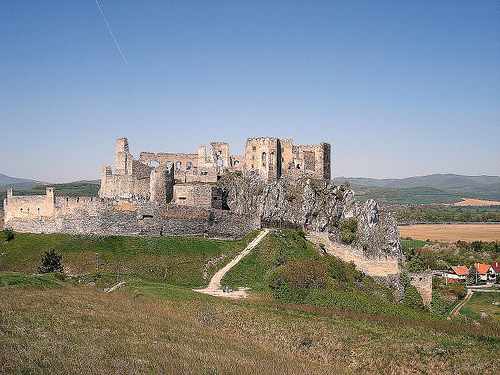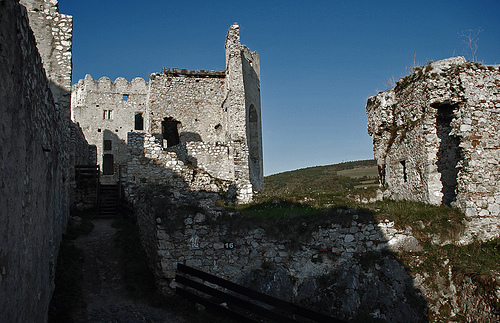

Location: Strazske and Humenne villages
Constructed: 13th century

Brekov Castle is a medieval citadel those ruins are visible on a Western spur of Vihorlatskych hill near a village of Strazske and Humenne. Brekov Castle was constructed in the 13th century. In the 15th century Brekov Castle was further increased in size to catch up with changing military technologies. In 1466 it saw clashes between armies of King Matthias Corvinus with Polish king Casimir IV. Between 1484 and 1488 Brekov Castle was further increased by Zapolsky. The end of the castle came in 1558 when its ownwer Francis Kendy joined the aristocratic opposition against king Ferdinand of Habsburg. Royal forces captured Brekov Castle and pillaged it. It was restored in 1575 by Nicholas Drugeth. It was again sacked and destroyed in 1644 by the troops of Juraj Rakoczi. Since then Brekov Castle was abandoned and used as a stone quarry by the local peasants. Today the castle is owned by the state. There no plans to restore the ruins, but it is probably for the best. In some places remains of the former medieval citadel reach up to third story.
In 1307 the castle was called Barko and later in 1314 possesio Borko cum castro, 1322 castrum Borkó and 1330 castrum Barkou, maď. Barkó.
The ruins of the castle stand on a bare hill in the western outcrop of the Vihorlat Hills 4 kilometers southwest of Humenné in the Laborca Valley above the village of the same name. It was built in the 13th century and belonged to the system of castles on the Hungarian - Polish road. In the first half of the 15th century, its fortifications were strengthened and shortly afterwards it played an important role in domestic political struggles, especially in 1466, when the troops of King Matej Korvín and his opponent, King Casimir IV of Poland, met in battle. In the years 1484 - 1488 it was in the hands of the Zápoľskýs, who expanded the castle and further improved its fortifications. In the middle of the 16th century, its owner František Kendy joined the aristocratic opposition against King Ferdinand of Habsburg, and therefore the royal army demolished the castle after the conquest in 1558. However, the later owner Mikuláš Druget repaired and restored it again in 1575. In 1644, the castle was attacked by the rebel troops of Juraj Rákoci and almost completely destroyed again. The partial repair of the residential tracts brought him back to life only briefly, because in the waves of the anti-Habsburg uprisings at the end of the 17th century, it definitely disappeared from it. Since then, the castle was deserted and to this day only the remains of the walls have been preserved.
The oldest core of the castle has an oval floor plan and is located on the highest point of the limestone cliff. It is joined by a tower on the southwest. This construction phase is from the turn of the 13th and 14th centuries. The second construction phase is connected with the Drugeth family, who added a two-winged palace to the tower and a small fort on the north side. During the extension of this fort to the east under Štefan Zápoľský, the old wall was replaced by new masonry on the edge of a rock plateau. In the fourth stage, they erected a late Gothic bastion at the entrance gate and added a polygonal building from the west to the original core.
To this day, the walls up to three storeys have been preserved, clearly indicating the previous condition of the buildings. The gates are also visible, the transition to the upper castle, which was probably equipped with a drawbridge. The cellars are partly vaulted and in the western part there is a clearly visible kitchen with an open fire, a sink and a huge flue. On the floor, the remains of the fireplace beams are preserved on the wall.
Until 1248, the owner of Michalovce (at that time a village with a large manor estate) was Sobieslav (Zabuslo) of the Ludaň family, of Slavic origin. He had extensive estates in central Zemplín, and he also owned the castles of Jasenov, Brekov and Vinné. It is first mentioned in written sources in 1307 as "castrum Barko" and Peter Peteň is mentioned as its owner. In 1317, Karol Róbert of Anjou donated the castle to Filip Drugeth, together with other estates in eastern Slovakia, for his faithful service. The Druget family owned the castle until 1486. In 1472, King Matej appointed Štefan Zápoľský as the hereditary county governor of Spiš and captain for the protection of the north-eastern regions of Hungary. In 1488 he appeared as "castellanus castri Barko". In the next two centuries, it was alternately owned by the Drugeth family and occupied by the troops of Gabriel Bethlén, Juraj Rákoczi I. (1644) and Imrich Thokoly, who had it demolished at the end of the conspiracy (1684). Currently, the owner of the castle is the village of Brekov. The administrator of the castle has been the Association for the Rescue of Brekov Castle since 2008.
Among the finds from the archaeological research of the Zemplín Museum in Michalovce, a rich collection of late Renaissance tiles has an important place. An even more important find are the finds of pottery, iron arrowheads of the Slavic fort. During the summer season, some finds are exhibited in the castle museum directly below the castle. Current opening hours are published on the website: Brekovský hrad - castle museum. (www.brekov.eu)
Новогоднее восхождение на замок Бреков
Организатор: Спасательная
ассоциация замка Бреков, Брековское городское управление
Официальный
сайт: Предновогоднее восхождение на замок Бреков (www.brekov.eu),
www.brekov.sk/obecny-urad
Дата события: 31 декабря
Маршрут: Бреков – замок Бреков
Тип
мероприятия: поход с возможностью посещения винного погреба замка
Организатор: Спасательная ассоциация замка Бреков, Брековское
городское управление
Официальный сайт: www.brekov.eu,
www.brekov.sk/obecny-urad
Дата события: ежегодно публикуется на фестивале «Замок Другет» в
замке Бреков. (www.brekov.eu)
Маршрут: Бреков – замок Бреков
Тип
мероприятия: походы с культурной программой по замку, фехтовальщикам и
другим старинным достопримечательностям